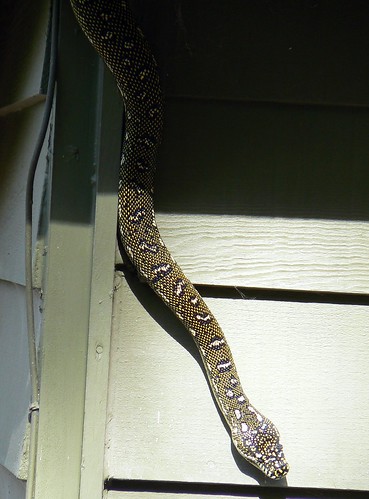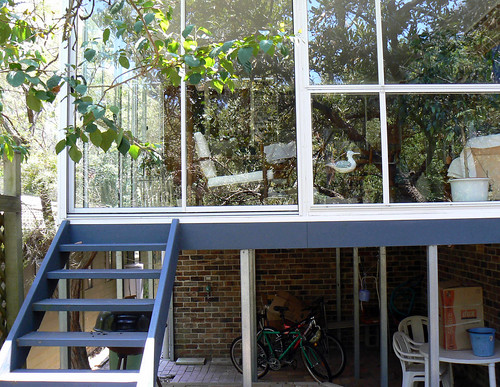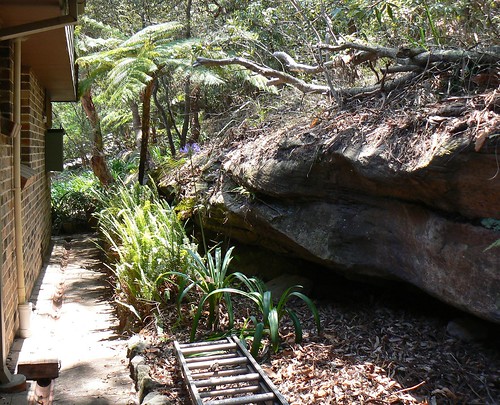Tuesday, October 30, 2007
2008 Plant Science Internship, National Herbarium of NSW--Applications open!
If you or anyone you know can spare 7 weeks in Jan-Feb next year to get advanced work experience and training in botanical science, here it is! (Oh, and that's me, third photo down, pretending to mount a specimen. So to speak.)
I'm going on the Internship's Central Coast field trip. My boss said to me, "We can't take you as a scientist, because you're not one yet, but would you like to be the cook?" So I'll be there, wearing the wacky, zany novelty BBQ apron, and hopefully doing a little botanising on the side.
Seriously, this is the greatest thing for someone with a passion for Australian plants, ecology and biodiversity. Pass it on!
Tuesday, July 10, 2007
'O frabjous day! Callooh! Callay!' She chortled in her joy.
It's been such a dream of mine to work at the Herbarium, since I did the Internship there. That, and the part time science degree.... Excuse me while I do a few handstands.
*bounce*
*bounce*
*bounce*
Sunday, July 08, 2007
Plant Science Internship Website Update
 Well, if this Wahlenbergia communis flower doesn't get your juices running, frankly, nothing will.
Well, if this Wahlenbergia communis flower doesn't get your juices running, frankly, nothing will.Isn't it a stunner? This is one of the photos on my updated Plant Science Internship pages. I've added a section on our Mount Annan Botanic Gardens field trip. Hope you'll take a look.
Tuesday, June 05, 2007
Website update
Wednesday, May 30, 2007
Burgeoning!
Busy times. I've been working hard on the garden. The beds near the front verandah were full of nasty exotic things, and they're gone now. In their place I've put in lots of new things, a goodly array of small trees, shrubs, monocots and ground covers.

In this bed is an established Ceratopetalum gummiferum, a New South Wales Christmas Bush, which has magnificent red sepals in summer. Against the lattice, I've planted Pandorea pandorana (Wonga Wonga vine). In front of those is an Acacia terminalis and a Grevillea olivacea x preissii which I grew at TAFE as one of my propagation assignments, and there are a couple of Goodenia ovata (with yellow flowers), to match the Acacia. I've planted a few Lomandra longifolia and Lomandra fluviatilis here and there, and in the foreground is a Zieria prostrata. Throughout, I've sown Dichondra repens seed as a ground cover.

This bed is very floral. I've planted as centrepieces, an Acacia fimbriata, a hybrid Leptospermum and a Corymbia ficifllia x ptychocarpa--the latter two have deep pink flowers. As smaller shrubs, I've planted Lomatia silaifolia, Crowea saligna and Melaleuca thymifolia. For ground covers, I've put in Brachyscome formosa, Brachyscome angustifolia, Brachyscome multifida, Wahlenbergia stricta, Dampiera diversifolia, Chrysocephalum apiculatum which will hopefully create a carpet of pink, blue and yellow. To create textural contrast, I added a few Patersonia sericea.
Once these become established, spring will bring a mass of colour! In my not too modest opinion.
Speaking of a lack of modesty, last week I was presented with the Award for Outstanding Graduate for my TAFE horticulture course last year! I was chuffed, especially when I discovered it entailed a book voucher from the wonderful bookshop Floreligium. Today the books I ordered arrived: the latest edition of "Frogs and Reptiles of the Sydney Region" by Ken Griffiths, and "Mycelium Running: how mushrooms can help save the world". Gorgeous.
My science degree begins in July. The course I'm starting with is Foundations for Resource and Environmental Management. I'm lowering myself back into tertiary education gently, so I'm starting with one course only.
The backyard vegie patch is coming on apace. Photos soon. I've planted peas, silver beet, rocket and cabbage, as well as nasturtiums and marigolds as companion plants, and I've mulched and set up an irrigation system and a fence to keep out the wallabies. They're looking good so far: no pests.
But alas, the wallabies got to my lemon tree. Now it has no leaves and no fruit. Still, they were here first so I can't complain. I've planted a Feijoa tree, but I'm not letting any damned marsupial near it. It's thoroughly protected by a plastic guard.
And I've started work on the pond. This really excites me! My plan is to put a waterfallish thing above a crack between two sandstone platforms. The water will flow down to pond number 1, and from there into a larger pond.
Update: I've started a new section on my Growing Passion website, devoted to the construction of the pond. Please take a look. I'll update it frequently, as the work gets done.
The first stage is removing huge tracts of the bloody agapanthus some nong planted. The more established plants have extensive root systems, and the only way to remove them is with brute force and lots of sweat. Still, it's satisfying work. And it's nice to have help. Here's Martien, hard at it. What a fine lad.

Agapanthus massacres are quite cathartic. During one I found a lone Epacris longiflora. It is looking rather sad, but now it's lost its competitors for space, light, nutrients and water, maybe it will be happier.
I also must tell you about the website of my friends, Stewart and Susie, on their swimming-pool-turned-into-pond: Pool to Pond. Stunning, huh? They're an inspiration. If you've a pool you don't want any more, forget about the expense of filling it in. This is the environmentally wonderful solution. Wouldn't you just love these plants and animals in your backyard?
Meanwhile, I'm continuing my volunteer work at the Herbarium's Plant Pathology Lab. Loving it to pieces. I'm even getting to do DNA extractions alone and without the aid of a net!
The closing date for applications for the Herbarium AVH position has ended. I've finished my application and mailed it off. It felt like a smallish novella. Please keep your fingers crossed for me.
Check out this gorgeous diamond python resident in the neighbours' roof! It vanished, apparently, during the bushfires, and rats invaded the roof. Now it's back and the rats are gone. I know which I'd prefer.

The other day, I saw a male Superb Lyrebird (Menura novaehollandiae) in the garden, right next to the house. Wish I could have got a pic, but it ran away too quickly, alas. Damn but I love the wildlife here....
Oh, and we've got a new puppy--a border collie--Trillian, as a companion for Miepje. Isn't she beautiful? But naughty. Very, very naughty. Like Miepje, we got her from the RSPCA. Unlike Miepje, she's not in the least traumatised by her early experiences. She's ridiculously confident about the world. Smart as a button.

Sunday, February 04, 2007
Flicking flowers, Fire and the Future
The first F relates to my photo of a Stylidium productum flower I posted here previously. It's just been published on Botany Photo of the Day, here. Thanks, Daniel! If you're into plants and you haven't yet subscribed to BPoD, then you should. Most of the photos there put mine to shame, but I'm pretty happy with those Daniel's published: Dendobium speciosum and Telopea speciosissima 'Wirrimbirra White'.
The slogan of Botany Photo of the Day is "In Science, beauty. In beauty, science. Daily." I love that. It distills what Dawkins talks about in Unweaving the Rainbow.
F #2 is fire. As I was travelling up to the Central Coast on a Herbarium internship field trip, we passed the bushfires that were besetting Mount Kuring-gai, less than a kilometre from our new home. This is a photo taken on 22 January, looking towards Sydney from Staples Lookout on the Kariong-Woy Woy Road, showing the smoke from the fire.

Such an ominous sight, and I hated being away from my family while we all worried.
We visited Mount Kuring-gai yesterday, to see the damage. While from the ridge you can see a lot of blackened damage from spot fires, the areas around the houses have only been browned by back-burning by the Rural Fire Service. It's distressing to know that the fire was caused either by an arsonist or by an idiot careless with a cigarette butt, but fortunately the fire near us wasn't too intense or extensive. Already there are signs of regeneration: lomandra appearing from the earth, xanthorrhoea leaves exploding from charred stumps. By the time we move in, there will be a lot of action. By the time the fire was controlled, a total of over 1,000 hectares were burnt. Hopefully most of the animals got out of the way....
But I'm afraid I'm not able to post any more photos from my Herbarium exploits yet. So many photos, so much to write, so little time! I'll catch up as soon as I can.
And the final F is my future. My experiences at the Herbarium have thoroughly crystallised my plans for the rest of my working life. A while ago I realised that horticulture wasn't going to be enough for me. Much as I love the practical stuff, I was craving more knowledge and science than my courses were designed to provide. Now I know where I want to go, and it's into botany and biodiversity.
So in the second half of this year, I'm going to go back to Macquarie University, my alma mater, and start studying for a B.Sc in Biodiversity and Conservation. I'll be studying part-time, so am going to look for part-time work in hort/plant science to pay for it. (It's a shock to the system for a girl who did her Arts/Law degrees during the halcyon post-Whitlam era, when tertiary education was entirely publicly-funded. Now, it's expensive. Yikes.)
Catch up soon!
Cheers,
Margaret
Friday, January 05, 2007
A New Home, a New Garden!
We're buying a home in Mt Kuring-gai, on the northern outskirts of Sydney. It's a beautiful place, backing onto Ku-ring-gai Chase National Park. Secluded, quiet, at the end of a cul de sac, and teeming with nature. It's the sort of place I've always dreamed of living in. During one of our inspections, a wallaby was grazing in the front garden!

Read about it and look at more photos here. You can see the region on Google Maps. (If it doesn't default to it, click on "satellite" so you can see all that gorgeous bushland!)
One of the most exciting aspects is its garden. It primarily has native plants but a few interlopers are there which I'll be excising. (Like the agapanthus. Can you believe that someone would plant agapanthus right next to a national park?)
In preparation, I've been making a list of all the native plants I'll be taking to plant out. Some are tube-stock I've bought or been given, some are in large pots and well established, and some I've propagated from seed or cuttings. The Lomandra 'Tanika' is in the ground, but I'll be digging it up--it's such a beautiful specimen I can't say good-bye to it.
Here is the list:
Acacia amblygona, Acacia fimbriata, Adiantum hispidulum, Archontophoenix cunninghamiana, Asplenium bulbiferum, Backhousia citriodora, Calothamnus quadrifidus, Cassinia denticulata, Clematis gentianoides, Crowea saligna, Darwinia citriodora, Derwentia perfoliata, Doodia aspera, Eucalyptus 'Summer Beauty', Eucalyptus macrocarpa, Goodenia ovata, Grevillea caleyi, Grevillea olivacea x preissii, Grevillea rhyolitica, Grevillea speciosa, Hardenbergia violacea, Hibbertia scandens, Kennedia prostrata, Kennedia rubicunda, Lepidozamia peroffskyana, Leptospermum scoparium, Lomandra 'Tanika', Lomandra longifolia, Melaleuca bracteata, Melaleuca linearifolia, Melaleuca thymifolia, Myoporum floribundum, Ozothamnus diosmifolius, Pandorea pandorana, Stenocarpus sinuatus, Stylidium productum, Stylidium adnatum, Telopea speciosissima, Telopea speciosissima 'Wirrimbirra White', Westringia fruticosa, Xanthorrhoea australis and Zieria smithii.
I've also a wish list of a few plants that are local to the area:
Clematis glycinoides – Old Man's Beard
Dianella prunina
Actinotus helianthi – Flannel Flower
Dampiera stricta – Blue Dampiera
Hypolepis muelleri – Harsh Ground Fern
Ceratopetalum gummiferum – NSW Christmas Bush
Correa reflexa
Grevillea buxifolia – Grey Spider Flower
I'm intending to do a proper garden scale plan, as we learned in the hort course last year. I've made notes on the habit, size, aspect and colouration for each species, to ensure they're happy and look as good as possible. It's a huge project, but I can think of none I'd rather do.
At the back of the house, under the sunroom is an open space which I'm commandeering to use as my hort headquarters. I'll put in shelves for my stuff, a whiteboard to keep records of propagating activities and a potting bench. Close by will be my greenhouse.

Naturally, one of the first things we'll be doing is setting up a water tank, and I'll use drip irrigation throughout the areas that will require watering, like the vegie patch. (Once established, the native plants will have to fend for themselves.) And, of course, there's be a frog pond.
There is an area between the house and a sandstone embankment that is just made to be a rainforest area, perfect for my ferns, tree ferns, zamia, elkhorns and asplenium. (Cool cave, huh? I wonder who lives there. And why does it need a ladder?)

We'll be moving in at the beginning of March. I haven't much time to think about it, though, because my Plant Internship starts on Monday and finishes the week before we move. More on the Internship soon.
2007 is starting spectacularly well for us. Let's hope it keeps going that way.Oh, and happy new year!
Cheers,
Margaret
Tuesday, December 05, 2006
Melaleuca thymifolia and other matters.
And today, I dropped in to college to clean up my cucumber patch and retrieve my stakes and trellis. It now looks very forlorn, but next year, it'll be tended lovingly by another student. I said bye to my favourite teachers (are you reading, Mark, Ian and John?) who are immersed in marking. Poor sods. I'll be missing the first month of my course next year, because of the internship. Things will be frenetic when I return.
A few weeks ago, I mentioned that I'd visited the Botanic Gardens and bought a few tubestock plants, including a Melaleuca thymifolia. It's now in flower, despite its youth, and the inflorescences are extraordinarily delicate. Most of this species seem to have pink flowers, but mine is a white variety. . . .

Once this plant is grown up I suspect it'll be a stunner.
Happy Planting!
Cheers,
Margaret
Thursday, November 23, 2006
Plant Science Internship
The internship takes place over January and February next year, full time. (This means that I'll have to miss my first month of my TAFE studies, but I think I'll be able to manage that okay with the support of my hort friends.)
From the Program's website:
This program offers undergraduates and recent graduates in the plant sciences advanced working experience in a leading scientific institution. The work program is supported by task-specific training and a professional-level introduction to key areas in Australian plant science and conservation. Specific training is given in skills for job-seeking and higher study....In other words, bliss on a stick.
The program is for students at the end of second or third year, and recent graduates, in botany, ecology, forestry, general biology (with plant interests), scientific horticulture, and related subjects. The program will benefit those seeking professional or technical careers in plant sciences or conservation management....
Interns work full-time on a voluntary, unpaid basis, assisting scientific staff on work of real scientific value. In return, Interns receive extensive practical training in botany, plant conservation, collections management, and job-seeking in the scientific workforce....
Training sessions are led by professional scientists and technicians from the Botanic Gardens Trust and other institutions. Training complements and extends that given at university....
- Work sessions
- Interns work in teams under staff supervision on routine and advanced tasks of specimen preparation, plant identification, collections management, and some research assistance.
- We attempt to accommodate interns’ interests, but allocation to work teams and tasks is at our discretion. The scientific context of all work is made clear – you will be making a real contribution to the running of the Herbarium and its programs, and the skills you acquire will be applicable in many other jobs, especially in science and conservation....
- Training About 40% of time is spent in training sessions. Again, these will be relevant to a wide range of science jobs. You will become familiar with:
- key sources of information on the Australian flora
- plant identification resources
- key sources of information in conservation science and policy
- principles and practice of the curation of scientific collections
- Seminar sessions will focus on theoretical and practical issues in botany and conservation, including current major research programs.
- Field training will include specimen selection and collection, field data recording, and permit and access protocols.
I fully intend to write here about my experiences at the Herbarium. And take lots of photos with the trusty camera.
Callooh! Callay! O frabjous day!
Sunday, October 29, 2006
Watch and be boggled.
I had a wonderfully horticultural weekend. On Saturday, my TAFE friend Julia introduced me to her friend Jill and Jill's remarkable garden near Yarramalong on the NSW Central Coast. I'll post some of the photos I took soon. I collected some Leptospermum petersonii capsules, now in a paper bag on the dashboard of my car so they'll open in the heat. And today, my daughter Maxine was rehearsing at the Sydney Opera House for a combined schools choir concert, so I busied myself by wandering about the Royal Botanical Gardens, where there just happened to be a tubestock sale. Oh my. I bought a few wee ones:
Gorgeous.